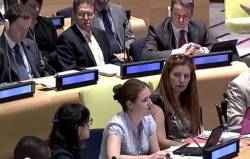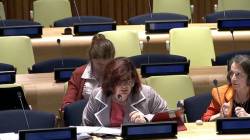 As the date for the expiration of the Millennium Development Goals (MDGs) fast approaches, debate around what a post-2015 development framework should look like has intensified. Between 17 and 19 June 2013 the fourth session of the Open Working Group on Sustainable Development Goals (OWG) met at the UN, with a focus on employment, decent work and social protection as well as on health and population dynamics.
As the date for the expiration of the Millennium Development Goals (MDGs) fast approaches, debate around what a post-2015 development framework should look like has intensified. Between 17 and 19 June 2013 the fourth session of the Open Working Group on Sustainable Development Goals (OWG) met at the UN, with a focus on employment, decent work and social protection as well as on health and population dynamics.
I had the privilege of flying the flag for old age alongside HelpAge’s Interim CEO Silvia Stefanoni. This was a key opportunity for us to directly feed into the post-2015 process, in particular on social protection, health and population dynamics.
During the first stakeholder meeting on Decent Work and Social Protection I was able to make a statement from the floor. At this stage, with multiple competing priorities, it was vital for us to stress the importance of social protection for the sustainable development agenda and the need to use the language of social protection floors within the post-2015 development framework. Questions from the co-chairs set the agenda for the discussion.
Silvia and I worked intensively in preparation for her statement from the floor on 19 June, where the focus was on health and population dynamics. The statement needed to highlight that ageing is a universal concern, that it is relevant to sustainable development and that, due to the invisibility of older people in data and analysis, we are unprepared to respond to the rights and entitlements of a growing older population.
It’s been inspiring to be in the chamber, shoulder to shoulder with the great and the good, striving to make the world a better place for the almost nine billion people that will make up its population by the end of the next framework. A daunting task, but on the whole I was energised by the many passionate interventions of member states, UN agencies and stakeholders and also by the dynamism of the dialogue overall.
It is exciting to have been part of the discussions which will help to shape a new framework, one that is relevant to the world universally, one that does not see “development” as a linear path, and one which goes beyond social goals to articulate economic and environmental aspirations for our future. Here, I share my reflections from the co-chairs’ meetings with representatives of major groups and other stakeholders.
From MDGs to SDGs
The stakeholder meetings provided an opportunity for civil society organisations to contribute to the debate. With so many competing demands, co-chair Mr. Csaba Kõrösi began the session by outlining four guiding questions:
1. What are the problems we want to address?
2. What does it take from us to make a transition?
3. What is the price of inaction?
4. What should the ambition level be?
Beyond these core questions, co-chair Mr. Macharia Kamau urged contributors to complement their statements with an indication of how financing and implementation, within the context of real budgets, could be achieved.
The role of social protection floors
The role of social protection floors was acknowledged early on by panellist Ms Alison Tate of the International Trade Union Confederation. Ms Tate reminded the group that the Rio+20 outcome document, which called for the establishment of the OWG, recognised that both decent work and social protection floors are “indispensable components in achieving internationally agreed development goals”. With responsibility for social protection held by national governments, public financing for social protection through domestic revenue is essential. However, Ms Tate also noted the need for an international mechanism on social protection, where technical assistance, as well as funding and resources, reflect international solidarity on this issue. Support for social protection floors was widespread within the chamber, with speakers from multiple organisations, including the Women’s Major Group and the International Disability Alliance, advocating for social protection floors.
Overall, I was encouraged and energised by the strong acknowledgement by member states of the important role social protection plays beyond poverty reduction, with recognition that it has a role in addressing wider issues, including inequality. Beyond this, a wide use of the language of social protection floors or, more broadly, rights-based social protection, was encouraging, with particularly strong statements from the representative of Fiji for the G77 group and China. As contributors were urged to consider implementation, this statement emphasised the importance of focusing first on coverage and then working towards improving efficiency through targeting.
Our statement on social protection
Social protection must be a goal, not a target. Social protection must be integral to the SDGs and the post-2015 development framework, recognising that social protection is a core enabler for healthy lives, productive livelihoods and environmental sustainability, not a set of residual policies for those left behind.
The language of social protection floors must be embedded throughout the post-2015 development framework. Social protection floor language is widely endorsed and based on a human-rights framework, it emphasises national ownership and has clear objectives against which progress can be measured.
The potential for sustainable financing already exists at the national level through the reallocation of national budgets.
An international mechanism to reflect global solidarity around social protection floors is achievable. The proposed Global Fund for social protection could provide the international mechanism called for by Ms Tate.
Data dearth
 On 19 June HelpAge’s Interim CEO Silvia Stefanoni made a statement on population dynamics (PDF). For a long time, HelpAge has been concerned about the dearth of data to guide policies around ageing. Data gaps such as within Demographic Health Surveys, which only include people up to the age of 49, are worrying in the context of ageing populations. Beyond the impact on the current generation of older people, evidence from countries such as Bangladesh suggests that development gains overall could be jeopardised if policy and practice fails to take into account demographic ageing.
On 19 June HelpAge’s Interim CEO Silvia Stefanoni made a statement on population dynamics (PDF). For a long time, HelpAge has been concerned about the dearth of data to guide policies around ageing. Data gaps such as within Demographic Health Surveys, which only include people up to the age of 49, are worrying in the context of ageing populations. Beyond the impact on the current generation of older people, evidence from countries such as Bangladesh suggests that development gains overall could be jeopardised if policy and practice fails to take into account demographic ageing.
It was heartening to see this data gap acknowledged both by the member state representative for Ireland, who also represented Denmark and Norway, as well Mr Kamau, co-chair and permanent representative to the UN from Kenya, whose reflections throughout have been insightful and powerful. Previously unaware of the extent of population ageing globally and in developing countries, as well as the extent of the data gaps, Mr Kamau was clear on the need to develop targets that speak to these issues. Beyond this, there was much debate around the need for a “data revolution”, with many civil society organisations and member states calling for age and gender disaggregated data.
While there was a recognition amongst member states of the potential impact of ageing and population dynamics on the outcomes of the next development framework, I was left with some concerns. Acknowledgement of a growing ageing population as a critical development issue is patchy. In particular, there has been insufficient acknowledgement of the challenges that age discrimination and the unmet needs of older populations will present for sustainable development overall. This perhaps relates to a lack of awareness around current data gaps that continue to keep the issues of old age and older people invisible.
Learn more
Watch the meeting on decent work and social protection online or read HelpAge’s statement on social protection.
Watch the meeting on health and population dynamics online or download HelpAge’s statement on population dynamics.
Read our recent briefing on social protection floors.
Learn more about how HelpAge is engaging with post-2015 debate.
